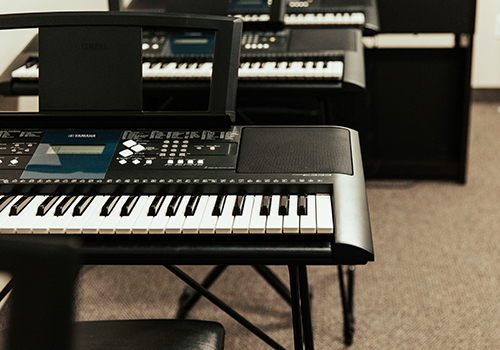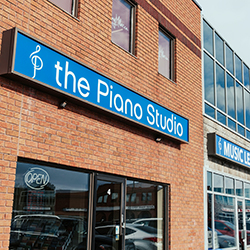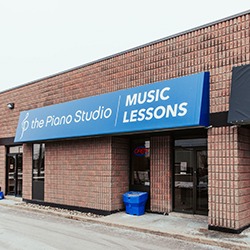Piano Buying Guide
How to Buy a Piano
There are many factors to consider when buying a piano and they will vary by importance depending on who is buying the piano and who will be playing it. So the best approach is to come visit our Newmarket piano showroom and we can ask you some questions and then give advice based on your unique situation. For those who like to read up ahead of time we present the following guide.

Your Unique Situation
When setting out to buy a piano it is important to ask yourself some questions to help set your priorities. For example, who will be playing the piano? Is it one person or several? Is the player a beginner, intermediate, or advanced player? More importantly, what skill level will the player(s) have in the future over the lifetime of the piano? Do you want to buy one piano now that will be sufficient as the player improves, or do you want to buy an entry piano now and upgrade later? How soon do you want to upgrade? Is the piano for recreational or professional use? What type of music will be played – is it primarily classical piano music, or does your family like pop, rock, jazz, and other types of music? Does your family embrace technology and use tablets and apps for learning and entertainment? Different pianos meet different combinations of these needs, but we can help you find the one that meets your unique situation.
Digital or Acoustic Piano?
A good way to start narrowing down the options is to decide whether an acoustic or digital piano is the best choice for you and your family. There are advantages and disadvantages to both. Ideally everyone would own one of each, but since most of us can’t afford both the question is: which is the better piano for your family right now? To help guide you in your decision, here are some key points to consider. The advantage of an acoustic piano is that it is the original and so still has a slight edge in sound and action. The disadvantages are that they are heavy, expensive to move, require regular tuning and maintenance, are sensitive to changes in humidity and temperature and are difficult to record. The disadvantages of a digital piano are that you may give up a little bit on sound and action (how much you give up depends on the quality of the digital piano). The advantages are that they never require tuning, are maintenance-free, much easier to move, more flexible on where they can be placed in your home, are easy to record, and can include many additional features such as iPad connectivity, learning exercises, interactive lessons, and much more. We find that for the vast majority of our customers, a digital piano makes the best choice. Most people today, and especially younger students, are used to using technology in every part of their lives and music is no exception. The versatility of a digital opens up all kinds of creative opportunities for creating and sharing music that didn’t exist even a few years ago. In addition, new hybrid instruments are starting to give us the best of both the acoustic and digital worlds.
Interested in purchasing an instrument?
At The Piano Studio we sell Roland digital pianos as well as a variety of used pianos. Whether it’s a general question or a request to try out an instrument, we’d love to help you out.
Factors to Consider When Buying a Digital Piano
The two most important considerations for most customers are the sound and the action. Also important are the speaker system, digital features and cabinet. These five things are the main drivers of the quality (and therefore cost) of a digital piano.
SOUND
The sound of a piano is actually a very complex thing resulting from the interplay of several sounds. It includes the hammers hitting the strings, the vibration of the strings, the vibration and amplification of the sound board, the reverberation from the piano’s cabinet, and any sympathetic resonance from other strings when the damper pedal (sustain pedal) is used. In addition, the tone of a single note changes with the volume; the tone starts out softer or warmer at low volume levels and gradually becomes harder or harsher at higher volume levels. To produce this sound faithfully, digital pianos employ both sampling and modeling. A sample is simply a recording. Because of the variation described above, good quality digital pianos will usually take several recordings (at different volume levels) for each of the 88 notes on an acoustic grand piano. Better quality brands will take more samples. They then use modeling to fill in the gaps between the samples, and to simulate how the different components of the piano sound interact together to create a true multi-dimensional sound experience. Higher quality brands and pianos have better software, and will include more components in their modeling. This create a better sound, but does cost more.
ACTION
The action of a piano is the physical mechanism that includes the keys and all the linkages which connect the keys to the hammers on acoustic pianos, and also includes the electronic sensors on digital and hybrid pianos. Every manufacturer has their own way of building an action and this is what gives every piano its unique “feel”. Playing a piano is a very physical, tactile experience and a lot of technique relates to how the player uses his or her fingers to manipulate the hammers indirectly through the keys and the action. This is why the action is so important. It is also why the action is the most difficult thing for a digital piano to accurately reproduce and one of the primary things which distinguishes a good quality digital piano from a lesser imposter. The action can be a source of anxiety if you are buying a piano but are not an experienced player yourself and are buying it for a beginner player. Beginner players will not know how to tell the difference between a good and poor quality action. But don’t worry – it is not as confusing at it seems! If you come visit our store we can help even someone with no piano experience to feel some of the differences in actions between piano models. In these cases it is important to choose a piano from a manufacturer with a good reputation for quality so that the player will establish a good baseline. The last consideration for action is the material that the keys are made out of. Historically, pianos had wooden keys covered in ivory because ivory is porous and textured so it absorbs moisture and helps players get a good grip on the keys. Ivory has been illegal since the 1970s so some piano manufacturers have developed synthetic ivory materials instead. Some digital pianos have simple plastic keys, while higher quality pianos make use of synthetic ivory for superior playability. Some digital pianos also have wooden keys for the most realism.
SPEAKERS
The speaker system in a digital piano has an important effect on the overall sound experience. If you play the same sound through two different speaker systems, it will sound better through the better speaker system. What makes a good speaker system? It is a combination of the quality of the speakers, the number of speakers, size of speakers, power, speaker placement, speaker cabinets, and how the sound is divided up and distributed among the speakers. Even if you don’t plan to play your piano very loudly, a better, more powerful speaker system will sound fuller and richer, even at low volumes. Usually as you spend more money on a digital piano the speaker system gets better and therefore the piano sounds more natural and realistic.
CABINETRY
A piano is a piece of furniture that will become part of your home so aesthetics are important. Pianos come in a variety of styles and finishes from traditional to contemporary. Be aware that for acoustic pianos a polished black finish (often called polished ebony) is the least expensive finish, while for digital pianos it is the most expensive. When looking at pricing, always make sure you understand which finishes are available for a given price. One of the advantages of digital pianos and modern speaker technology is that cabinetry can be made quite compact which can be good for families who have a limited amount of space.
DIGITAL FEATURES
There is an almost limitless variety of extra features that are made possible with digital pianos. This section will summarize the most important ones.
HEADPHONES
All digital pianos will have the ability to play using headphones which is very important for many households. They allow focused practice in the midst of busy households, and can be very valuable if the piano is located in a shared space where other family members might be watching TV or talking on the phone. They are also important if a parent wants to play piano after the kids are in bed, or if a teenager wants to play after parents are in bed!
METRONOME
Most digital pianos will have a built-in metronome which is important especially for beginner players to help learn how to keep steady time, and also for more advanced students to establish the proper tempo for a new piece.
ADDITIONAL SOUNDS
Most digital pianos will also have additional sounds (also called tones or voices) other than just piano, such as strings, organs, brass, etc. These sounds can help make practicing more interesting and fun for beginners, and can help all players who want to enjoy a variety of musical genres and styles. If these additional sounds are something you will use, then you may want to spend a bit more for a model with a larger variety of sounds.
RHYTHMS AND ACCOMPANIMENT
Digital pianos with rhythm accompaniment allow you to add a backing band to your playing. The piano will add a drummer, bass player, and other musicians who will automatically follow along based on the chords you play. This can be a lot of fun for musicians who enjoy rock, jazz, blues, Latin and other forms of popular music. It can also make practicing simple songs more fun for beginners.
LESSONS AND LEARNING
Some digital pianos come with a large colour screen and many interactive applications such as lessons, finger training, note-reading practice, theory games, and songs to play along with and learn. While these will not replace a human teacher they are very valuable as supplemental learning aids and help make practicing fun. The lesson features should scale so that they are valuable for a variety of ages and levels.
TABLET CONNECTIVITY
Some digital pianos now have the ability to connect to an iPad or other tablet and many piano manufacturers and third party developers have musical apps which can be fun and educational. This is the future of music! These applications open up limitless opportunities to learn, play, create, enjoy, and share music in old and new ways. Be sure to ask what type of connectivity your piano supports.
RECORDING
Most digital pianos can record at least one song, which is enough for most players. This allows you to record your practicing and play it back to help identify areas that need improvement. Some models will include the ability to save the file to a USB key so it can be shared with others. Anyone who is interested in composing or more advanced recording will want to find a piano which allows additional songs to be recorded or one with a full 16-track sequencer so they can add multiple layers. The best digital pianos will allow you to record in both MIDI and audio formats.
STAGE PERFORMANCE
Piano players who perform on stage will want to look for a digital piano that caters to their specific needs such as on-board EQ, the ability to save settings in easily accessible set lists, and the ability to blend multiple sounds on the fly. They will also want a piano that is portable and durable to withstand repeated set-ups and teardowns.
Two Convenient Locations
We have grown to become one of the largest music schools in the Newmarket/Aurora area by constantly challenging ourselves to offer the best music lesson programs available and to exceed our customers’ expectations.





